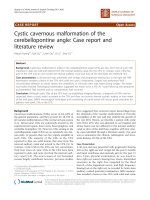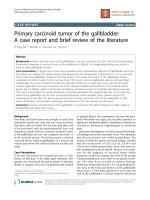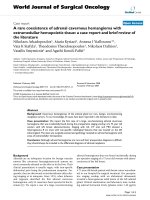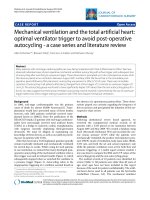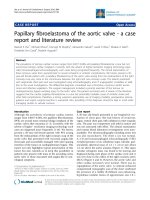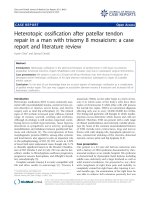Malignant mesothelioma of the pleura with desmoplastic histology: A case series and literature review
Bạn đang xem bản rút gọn của tài liệu. Xem và tải ngay bản đầy đủ của tài liệu tại đây (1.65 MB, 6 trang )
Hashimoto et al. BMC Cancer (2016) 16:718
DOI 10.1186/s12885-016-2745-8
CASE REPORT
Open Access
Malignant mesothelioma of the pleura with
desmoplastic histology: a case series and
literature review
Kana Hashimoto1, Yusuke Okuma1,2* , Yukio Hosomi1 and Tsunekazu Hishima3
Abstract
Background: Desmoplastic malignant pleural mesothelioma (DMM) is rare histological subtype of diffuse malignant
pleural mesothelioma (MPM), accounting for 5–10 % of cases. It has a poor prognosis, with direct invasion of the
chest wall or lungs and distant metastases. Its pathological characteristics include dense collagen fibers in a
storiform pattern. Its pretreatment pathological diagnosis is difficult, with fibrous pleuritis and reactive mesothelial
hyperplasia as potential differential diagnoses.
Case presentation: We retrospectively reviewed the medical charts of patients with MPM from 1996 to 2012.
Among 60 patients with MPM, four patients with the desmoplastic subtype were identified and their clinical
characteristics, including asbestos exposure, treatment, and prognosis, were reviewed. All of the patients with DMM
were men, with a median age of 69 years (range: 63–74 years). All four patients had been exposed to asbestos. The
definitive diagnosis was made histologically and the International Mesothelioma Interest Group classification was
advanced (III/IV: 2/3) in all four patients. Three patients were treated with chemotherapy (two with cisplatin/pemetrexed
and one with cisplatin/gemcitabine) and one patient underwent surgery. The median survival time in the patients with
DMM was 3.8 months (range: 0.9–11.5 months), compared with 10.5 months in patients with other subtypes of MPM in
our institution.
Conclusions: DMM continues to have a poor prognosis. It is important to recognize this variant and distinguish it from
pleural plaques, non-specific reactive pleural fibrosis, pleurisy, and other lung diseases.
Keywords: Desmoplastic, Mesothelioma, Chemotherapy, Prognosis
Abbreviations: DMM, Desmoplastic malignant mesothelioma; IHC, Immunohistochemistry; MPM, Malignant pleural
mesothelioma
Background
Malignant mesothelioma is a rare cancer arising in body
cavities lined by mesothelium, commonly including the
pleura [1]. A recent report suggested an increasing trend
of malignant mesothelioma incidence, and that it was
still associated with a poor prognosis. Asbestos exposure,
often as an occupational hazard, has been clearly linked
to the occurrence of malignant pleural mesothelioma
* Correspondence:
1
Department of Thoracic Oncology and Respiratory Medicine, Tokyo
Metropolitan Cancer and Infectious diseases Center Komagome Hospital,
3-18-22 Honkomagome, Bunkyo, Tokyo 113-8677, Japan
2
Division of Oncology, Research Center for Medical Sciences, Jikei University
School of Medicine, Tokyo, Japan
Full list of author information is available at the end of the article
(MPM) [2]. MPM has a poor prognosis, with a median
survival of 4–12 months due to a lack of successful curative treatments and its diagnosis at an advanced stage
[3]. MPM is categorized histologically as epithelioid, sarcomatoid, or biphasic [1, 4] subtypes, which account for
55, 15, and 30 % of MPM patients, respectively.
Desmoplastic malignant mesothelioma (DMM) was
first described by Kannerstein and Churg in 1980 [5],
and comprises a relatively rare, specific histological subtype of sarcomatoid tumor [6]. Since its initial report,
the number of cases of DMM has continued to increase
sporadically, and it is thought to constitute 5–10 % of all
patients with MPM. DMM is characterized by dense,
collagenized tissue (>50 %) separated by atypical cells
© 2016 The Author(s). Open Access This article is distributed under the terms of the Creative Commons Attribution 4.0
International License ( which permits unrestricted use, distribution, and
reproduction in any medium, provided you give appropriate credit to the original author(s) and the source, provide a link to
the Creative Commons license, and indicate if changes were made. The Creative Commons Public Domain Dedication waiver
( applies to the data made available in this article, unless otherwise stated.
Hashimoto et al. BMC Cancer (2016) 16:718
Page 2 of 6
arranged in a storiform or “patternless” pattern, present in
at least 50 % of the tumor specimen. Immunohistochemical (IHC) staining is useful for making a diagnosis, although the appropriate combination of antibodies needs
to be selected for a comprehensive assessment. It is also
crucial to distinguish DMM from benign lesions involving
pleural fibrosis because of their different treatments and
prognoses. However, the characteristics of this relatively
rare histological subtype of mesothelioma remain unclear.
In this study, we investigated the clinical characteristics
and outcomes of four patients with DMM and conducted
a literature review.
thoracoscopic surgery (VATS) at a different institution
3 years previously. Chest computed tomography (CT)
revealed pleural effusion with thickened pleura. VATS
of the pleura was performed, and the histopathological
examination revealed thickening with collagen fibrous
hyperplasia and invasion of inflammatory cells, mainly
comprising plasma cells. The collagen fibers were irregular, with poor alignment. These characteristics were consistent with DMM. He was also diagnosed with T4N0M0
stage IV according to iMig stage. The patient was initially
treated with hyperthermic intrathoracic chemotherapy at
a dose of 10 Gy in 10 fractions, with palliative intent.
Although his tumor shrank by 13 %, he died suddenly
of cardiopulmonary arrest at home at 11.6 months after
starting the treatment.
Methods
Database and data acquisition
We retrospectively investigated patients with a histological
or cytological diagnosis of MPM at the Tokyo Metropolitan
Cancer and Infectious diseases Center Komagome Hospital
(Tokyo, Japan) between 1996 and 2012. We used the International Classification of Diseases (9th edition) codes to
identify relevant patients from the database. The patients’
clinical data were acquired from electronic charts.
The pathological diagnoses were reviewed by a pathologist (TH) in accordance with the 2004 World Health
Organization classification [7], based on hematoxylin–
eosin staining and additional IHC staining. The relevant
clinical features and treatment-related data for 60 patients
diagnosed with MPM were retrospectively reviewed.
Among these patients, four were diagnosed with DMM.
Staging and best objective responses were based on the
International Mesothelioma Interest Group (iMig) recommendations [8, 9]. The patients’ baseline characteristics
were summarized using descriptive statistics. The results
are summarized in Table 1 Also, Radiographic and pathological images of each patient are attached in the Additional files (Additional file: 1, 2, 3, 4).
Case 2
A 73-year-old man was initially referred to our institution
with dyspnea on exertion. No lesion was present on CT
for the first 5 months, but a new lesion appeared at
5.9 months. Based on the results of VATS, he was diagnosed with DMM of T3N0M0 stage III. Cells with
spindle-shaped or round nuclei were loosely scattered
among dense hyaline collagen fibers in the visceral
pleura. IHC revealed tumor cells positive for CAM 5.2,
calretinin, CD5/6, and D2-40, but negative for carcinoembryonic antigen, HBME, and thrombomodulin.
He was thus diagnosed with DMM. He was treated with
one cycle of cisplatin and gemcitabine combination
chemotherapy, followed by carboplatin and gemcitabine
because of poor performance status. However, he died of
disease progression 8.1 months after initial diagnosis.
Case 3
A 74-year-old man was referred to our hospital with
cough and dyspnea on exertion. CT revealed a large
pleural effusion. Cytology class III showed bloody effusion, and MPM was suspected (Fig. 1-a, c, e). A VATS
biopsy revealed proliferated spindle cells and irregular,
dense, hyalinized collagen fibers (Fig. 2-a, b). The collagen fibers in the pleura were aligned irregularly, demonstrating a partial storiform pattern. IHC revealed tumor
cells positive for calretinin, p53, WT1, smooth muscle
actin, and desmin but negative for CD5/6 and EMA
(Fig. 2-c, d). He was diagnosed with stage III DMM.
Case presentations
Case 1
A 69-year-old man was referred to the Tokyo Metropolitan
Cancer and Infectious diseases Center Komagome Hospital,
with complaints of cough with hemoptysis, weight loss, and
an abnormal chest radiograph. He also had diabetes, dyslipidemia, and a history of tuberculosis. He had been diagnosed with non-specific pleural thickness by video-assisted
Table 1 Patient characteristics and survival
Gender
Asbestos exposure
Diagnostic methods
Age
Stages (IMIG Classification)
Treatment
Case 1
Male
+
VATS
69
T4N3M0 Stage IV
HITC
Case 2
Male
+
VATS
73
T3N0M0 Stage III
CDDP + GEM
Case 3
Male
Unknown
VATS
74
T1N2M0 Stage III
CDDP + PEM
4.7
Case 4
Male
+
VATS
63
T4N2M0 Stage IV
CDDP + GEM
0.9
VATS video-assisted thoracic surgery, HITC hyperthermic intrathoracic chemotherapy, CDDP cisplatin, GEM gemcitabine, PEM pemetrexed
Survival (months)
11.6
8.1
Hashimoto et al. BMC Cancer (2016) 16:718
Page 3 of 6
Fig. 1 Chest computed tomography of DMM lesions (Case 3) before (a), (c), (e) and after cisplatin and pemetrexed chemotherapy (b), (d), (f)
Systemic chemotherapy with cisplatin and pemetrexed
combination therapy was initiated but discontinued after
two cycles because of renal impairment. Disease progression occurred with a 28 % increase in tumor size
(Fig. 1-b, d, f ), and he died of acute renal dysfunction
4.7 months after initial diagnosis.
Case 4
A 63-year-old man was admitted to the hospital suffering
from right anterior chest pain. He had pleural thickening
and suspected MPM. He underwent CT-guided biopsy,
but no definitive diagnosis was made. Therefore, he underwent VATS biopsy, which showed dense collagen fibers in
the chest muscle and fatty tissue. The collagen fibers were
mixed or fused with hyaline. Spindle cells were increased
among the collagen fibers, and focal inflammatory cell
invasion was noted. IHC was positive for CAM5.2 and
calretinin and negative for CD5/6, AE1/AE3, HBME-1,
and thrombomodulin. He was diagnosed with stage IV
DMM. He received one cycle of cisplatin and gemcitabine
Hashimoto et al. BMC Cancer (2016) 16:718
Page 4 of 6
Fig. 2 Pathological findings of a VATS-resected specimen (Case 3). Low-power image shows focal proliferation of cuboidal atypical cells with
round nuclei and prominent nucleoli surrounded by fibrous tissue. Keratinization, plasmodesmata, and glandular construction were absent (a).
High-power image of DMM (b). IHC demonstrated positivity for calretinin (c) and CAM5.2 (d)
combination chemotherapy to no effect, with rapid clinical
disease progression. He died 0.9 months after the hospital
admission, and autopsy confirmed DMM.
Discussion
DPM is a relatively rare histological subtype of MPM with
sarcomatoid histology, with a generally poor prognosis.
We report four patients with DMM who demonstrated
poor prognoses and in whom diagnosis was delayed.
The clinical behavior of MPM is characterized by local
spread, large pleural effusions, and metastases to regional
lymph nodes, while the sarcomatous subtype of MPM is
more frequently associated with distant metastases, but
with little or no effusion, and mixed mesotheliomas have
intermediate features. Distant metastases occur in 60.1 %
of patients with DMM [10], and a higher incidence of metastases has been reported for DMM compared with other
series of MPM [5]. Among the biphasic and sarcomatous
subtypes of tumors, more than 50 % of the tumor consists
of dense, hypocellular collagenous tissue, and these tumors have been termed DMM. Although MPM is clearly
associated with exposure to asbestos, the association
between DMM and asbestos exposure is controversial
[11, 12]. However, all four of the current patients had
been exposed to asbestos.
Sarcomatoid components, large cellular vacuolization,
infrequent psammoma bodies, and the existence of hyaluronic acid are common pathological findings [13]. It is
essential to differentiate DMM from other benign lesions,
such as fibrous pleurisy and solitary fibrous tumors, because of important differences in treatment and prognosis;
however, it is often difficult to distinguish between these
diseases both radiologically and clinically. Pathological
diagnosis is the most reliable diagnostic method, although
it is difficult to perform with a small amount of specimen
[14]. IHC staining plays a crucial diagnostic role, in that
solitary fibrous tumors are positive for CD34 and bcl-2,
but negative for calretinin and HBME-1. Furthermore, collagen necrosis may provide a diagnostic clue in nearly
75 % of patients [10, 15, 16]. Given the difficulty in differentiating between DMM and fibrous pleurisy, early invasive interventions, including VATS, may be indicated if
MPM is suspected. IHC staining can provide additional
diagnostic information to the characteristic histological
findings [11, 17]. In the current series, it was necessary to
differentiate between DMM and fibrous pleurisy in Cases
1 and 4, although all cases were ultimately diagnosed definitively by histology. Recently, the classification system
for DMM has been updated. Previously considered an independent histological classification in 2004, DMM is now
sub-categorized under sarcomatoid histology (however,
Hashimoto et al. BMC Cancer (2016) 16:718
still now independently described). In addition, the role of
IHC has been emphasized, and broad-spectrum staining
for cytokeratins is crucial for the correct diagnosis of
DMM. In addition, the criteria for distinguishing malignant mesothelioma from reactive mesothelial proliferations have been further refined. In addition, the use of p16
FISH promises to yield observations in mesothelioma
pathology useful for distinguishing it from benign pleuritic
[18]. Furthermore, based on a previous case report [19],
positron emission tomography (PET)/CT has been clinically useful for determining a CT-guided biopsy site;
however, the present cases did not undergo PET/CT.
DMM is associated with more distant metastases than
other histologies [10]. The median survival time of
sarcomatoid-type MPM is 5.5 months. DMM also has a
poor prognosis, but the rarity of this subtype means that
its detailed characteristics are poorly known. Our series
included patients with advanced-stage disease, including
two with stage III and two with stage IV, according to
iMig staging.
The current standard of care for MPM involves multimodality treatment. However, having difficulties with early
diagnosis means that most patients are diagnosed with
advanced-stage disease. MPM is characterized as highly
malignant, aggressive, and refractory to local treatment,
resulting in survival times of 12–36 months for localized
disease and 8–14 months for advanced disease [3].
Current therapies are expected to prolong survival time
and improve quality of life in patients with MPM [20].
However, the survival time of untreated patients with
MPM was 11.5 months, whereas that for patients with sarcomatoid type MPM treated with supportive care was only
5–6 months [10, 11]. Furthermore, patients may take up
to 1–2 years to develop symptoms [10, 21].
There is currently no definitive treatment for DMM,
and it is generally managed according to MPM guidelines.
National Comprehensive Cancer Network guidelines
recommend chemotherapy alone [3], and the present
regimen for first-line chemotherapy consists of cisplatin
plus pemetrexed, based on a median overall survival of
13.3 months, compared with 12.7 months for cisplatin
alone [22]. A recent phase III clinical trial demonstrated
survival of 18.8 months with bevacizumab, cisplatin, and
pemetrexed, compared with 16.1 months for cisplatin and
pemetrexed (hazard ratio (HR) = 0.77; 95 % confidence
interval (CI): 0.62–0.95; p = 0.0167) [23]. According to
subgroup analyses, bevacizumab was associated with
advantages in sarcomatoid or mixed histology MPMs
(HR = 0.64; 95 % CI: 0.40–1.02 and HR = 0.82; 95 % CI:
0.64–1.06; p = 0.29, respectively) [23]. From this standpoint, patients diagnosed with sarcomatoid histology,
including DMM, may be well-advised to add bevacizumab to their chemotherapy regimen. Carboplatin-based
chemotherapy in combination with pemetrexed [24, 25]
Page 5 of 6
or gemcitabine are allowed [26, 27]. All of the patients
in the current study were diagnosed in advanced stages.
One patient underwent surgery, and the other three were
treated with cisplatin-based chemotherapy, though chemotherapy was ineffective. The survival times ranged from 0.9
to 11.5 months, which indicated a poorer prognosis than
for other histological subtypes of MPM, which had a
median survival time of 10.5 months.
Conclusions
We reported on four patients with DMM in whom diagnosis was only made at an advanced stage, and who had
poor prognoses, as noted in previous reports.
Additional files
Additional file 1: Figure-CT-case-1. Chest computed tomography of
DMM lesions of Case 1. Figure-path-case-1 (a) Low-power image of case 1.
(b) High-power image of case 1. (ZIP 10146 kb)
Additional file 2: Figure-CT-case-2. Chest computed tomography of
DMM lesions of Case 2. Figure-path-case-2 (a) Low-power image
showed focal proliferation of cuboidal atypical cells with round nuclei
and prominent nucleoli surrounded by fibrous tissue. Keratinization,
plasmodesmata, and glandular construction were absent. (b) High-power
image of DMM. IHC demonstrated positivity for (c) calretinin and (d)
CAM5.2. (ZIP 11113 kb)
Additional file 3: Figure-CT-case-3. Chest computed tomography of
DMM lesions of Case 3. Figure-path-case-3 Pathological findings of
VATS-resected specimen of Case 3. (a) Low-power image showed focal
proliferation of cuboidal atypical cells with round nuclei and prominent
nucleoli surrounded by fibrous tissue. Keratinization, plasmodesmata, and
glandular construction were absent. (b) High-power image of DMM. IHC
demonstrated positivity for (c) calretinin and (d) CAM5.2. (ZIP 10747 kb)
Additional file 4: Figure-CT-case-4. Chest computed tomography of
DMM lesions of Case 4. Figure-path-case-4 (a) Low-power image of case 4.
(b) High-power image of case 4. (ZIP 7796 kb)
Acknowledgment
The authors would like to thank Enago () for English
language editing.
Funding
No specific funding was received for this work.
Availability of data and materials
All relevant data are within the manuscript.
Authors’ contributions
YO and KH acquired the clinical data and drafted the manuscript. YO and YH
were responsible for the clinical management of the patients. TH was
responsible for the pathological diagnoses. YO, KH, YH, and TH were
responsible for interpretation of the data and critical revision of the
manuscript. All authors have read and approved the final manuscript.
Competing interests
The authors declare that they have no competing interests.
Consent for publication
Written informed consent was obtained from the patients or patients’ family
for publication of this case series. A copy of the written consent is available
for review by the Editor-in-Chief of this journal.
Hashimoto et al. BMC Cancer (2016) 16:718
Ethics approval and consent to participate
The study was approved by the Ethics Committee of Tokyo Metropolitan
Cancer and Infectious disease Center Komagome Hospital was also in
accordance with the Declaration of Helsinki in 2013. The clinical information
presented in this case series was obtained through Tokyo Metropolitan
Cancer and Infectious disease Center Komagome Hospital’s medical records.
Author details
1
Department of Thoracic Oncology and Respiratory Medicine, Tokyo
Metropolitan Cancer and Infectious diseases Center Komagome Hospital,
3-18-22 Honkomagome, Bunkyo, Tokyo 113-8677, Japan. 2Division of
Oncology, Research Center for Medical Sciences, Jikei University School of
Medicine, Tokyo, Japan. 3Department of Pathology, Tokyo Metropolitan
Cancer and Infectious diseases Center Komagome Hospital, Tokyo, Japan.
Received: 19 January 2016 Accepted: 23 August 2016
References
1. Klebe S, Brownlee NA, Mahar A, Burchette JL, Sporn TA, Vollmer RT, Roggli
VL. Sarcomatoid mesothelioma: a clinical-pathologic correlation of 326
cases. Mod Pathol. 2010;23(3):470–9.
2. Bianchi C, Bianchi T. Global mesothelioma epidemic: trend and features.
Indian J Occup Environ Med. 2014;18(2):82–8.
3. Ettinger DS, Akerley W, Borghaei H, Chang A, Cheney RT, Chirieac LR,
D'Amico TA, Demmy TL, Ganti AK, Govindan R, et al. Malignant pleural
mesothelioma. J Natl Compr Canc Netw. 2012;10(1):26–41.
4. Inai K. Pathology of mesothelioma. Environ Health Prev Med. 2008;13(2):60–4.
5. Kannerstein MJC. Desmoplastic diffuse malignant mesothelioma. Prog Surg
Pathol. 1980;1:19–27.
6. Gibbs AR, Thunnissen FB. Histological typing of lung and pleural tumours:
third edition. J Clin Pathol. 2001;54(7):498–9.
7. Travis W, Brambilla W, Müller-Hermelink H, Harris C. World Health
Organization classification of tumors. Pathology and genetics of tumors of
the lung, pleura, thymus and heart. Chapter 3. Lyon: IARC press; 2004.
8. Scherpereel A, Astoul P, Baas P, Berghmans T, Clayson H, de Vuyst P, Dienemann
H, Galateau-Salle F, Hennequin C, Hillerdal G, et al. Guidelines of the European
Respiratory Society and the European Society of Thoracic Surgeons for the
management of malignant pleural mesothelioma. Eur Respir J. 2010;35(3):479–95.
9. Byrne MJ, Nowak AK. Modified RECIST criteria for assessment of response in
malignant pleural mesothelioma. Ann Oncol. 2004;15(2):257–60.
10. Cantin R, Al-Jabi M, McCaughey WT. Desmoplastic diffuse mesothelioma.
Am J Surg Pathol. 1982;6(3):215–22.
11. Wilson GE, Hasleton PS, Chatterjee AK. Desmoplastic malignant
mesothelioma: a review of 17 cases. J Clin Pathol. 1992;45(4):295–8.
12. Ishikawa R, Kikuchi E, Jin M, Fujita M, Itoh T, Sawa H, Nagashima K.
Desmoplastic malignant mesothelioma of the pleura: autopsy reveals
asbestos exposure. Pathol Int. 2003;53(6):401–6.
13. Ordonez NG. Role of immunohistochemistry in distinguishing epithelial
peritoneal mesotheliomas from peritoneal and ovarian serous carcinomas.
Am J Surg Pathol. 1998;22(10):1203–14.
14. Mangano WE, Cagle PT, Churg A, Vollmer RT, Roggli VL. The diagnosis of
desmoplastic malignant mesothelioma and its distinction from fibrous
pleurisy: a histologic and immunohistochemical analysis of 31 cases
including p53 immunostaining. Am J Clin Pathol. 1998;110(2):191–9.
15. Roggli VL, Kolbeck J, Sanfilippo F, Shelburne JD. Pathology of human
mesothelioma. Etiologic and diagnostic considerations. Pathol Annu.
1987;22 Pt 2:91–131.
16. Bolen JW, Hammar SP, McNutt MA. Reactive and neoplastic serosal tissue.
A light-microscopic, ultrastructural, and immunocytochemical study. Am J
Surg Pathol. 1986;10(1):34–47.
17. Travis W, Brambilla E, Burke AP, Marx A, Nicholson AG. WHO classification of
tumours of the lung, pleura, thymus and heart, vol. 7. 4th ed. Lyon: IARC
Press; 2015. p. 154–81. Chapter 2.
18. Galateau-Salle F, Churg A, Roggli V, Travis WD, World Health Organization
Committee for Tumors of the P. The 2015 World Health Organization
classification of tumors of the pleura: advances since the 2004 classification.
J Thorac Oncol. 2016;11(2):142–54.
19. Ishioka Y, Nakagawa H, Yamamoto K, Shimoyama A, Yagihashi N. A case of
desmoplastic malignant mesothelioma diagnosed by CT-guided biopsy
based on PET-CT. Ann Jpn Respir Soc. 2014;3(2):255–9.
Page 6 of 6
20. Rosenzweig KE. Current readings: improvements in intensity-modulated
radiation therapy for malignant pleural mesothelioma. Semin Thorac
Cardiovasc Surg. 2013;25(3):245–50.
21. Nakamura H, Kitada O, Aragane K, Miyata S, Kodama T, Kuribayashi K,
Nakagomi T, Takenaka N, Jin S, Nagasawa M, et al. A case of desmoplastic
malignant mesothelioma with elevated serum CYFRA 21–1. Nihon Kokyuki
Gakkai Zasshi. 2002;40(4):337–40.
22. Vogelzang NJ, Rusthoven JJ, Symanowski J, Denham C, Kaukel E, Ruffie P,
Gatzemeier U, Boyer M, Emri S, Manegold C, et al. Phase III study of
pemetrexed in combination with cisplatin versus cisplatin alone in patients
with malignant pleural mesothelioma. J Clin Oncol. 2003;21(14):2636–44.
23. Zalcman G, Mazieres J, Margery J, Greillier L, Audigier-Valette C, Moro-Sibilot
D, Molinier O, Corre R, Monnet I, Gounant V, et al. Bevacizumab for newly
diagnosed pleural mesothelioma in the Mesothelioma Avastin Cisplatin
Pemetrexed Study (MAPS): a randomised, controlled, open-label, phase 3
trial. Lancet. 2016;387(10026):1405–14.
24. Ceresoli GL, Zucali PA, Favaretto AG, Grossi F, Bidoli P, Del Conte G, Ceribelli
A, Bearz A, Morenghi E, Cavina R, et al. Phase II study of pemetrexed plus
carboplatin in malignant pleural mesothelioma. J Clin Oncol. 2006;24(9):1443–8.
25. Katirtzoglou N, Gkiozos I, Makrilia N, Tsaroucha E, Rapti A, Stratakos G,
Fountzilas G, Syrigos KN. Carboplatin plus pemetrexed as first-line treatment
of patients with malignant pleural mesothelioma: a phase II study. Clin
Lung Cancer. 2010;11(1):30–5.
26. Favaretto AG, Aversa SM, Paccagnella A, Manzini Vde P, Palmisano V, Oniga
F, Stefani M, Rea F, Bortolotti L, Loreggian L, et al. Gemcitabine combined
with carboplatin in patients with malignant pleural mesothelioma: a
multicentric phase II study. Cancer. 2003;97(11):2791–7.
27. Aversa SM, Favaretto AG. Carboplatin and gemcitabine chemotherapy for
malignant pleural mesothelioma: a phase II study of the GSTPV. Clin Lung
Cancer. 1999;1(1):73–5.
Submit your next manuscript to BioMed Central
and we will help you at every step:
• We accept pre-submission inquiries
• Our selector tool helps you to find the most relevant journal
• We provide round the clock customer support
• Convenient online submission
• Thorough peer review
• Inclusion in PubMed and all major indexing services
• Maximum visibility for your research
Submit your manuscript at
www.biomedcentral.com/submit

